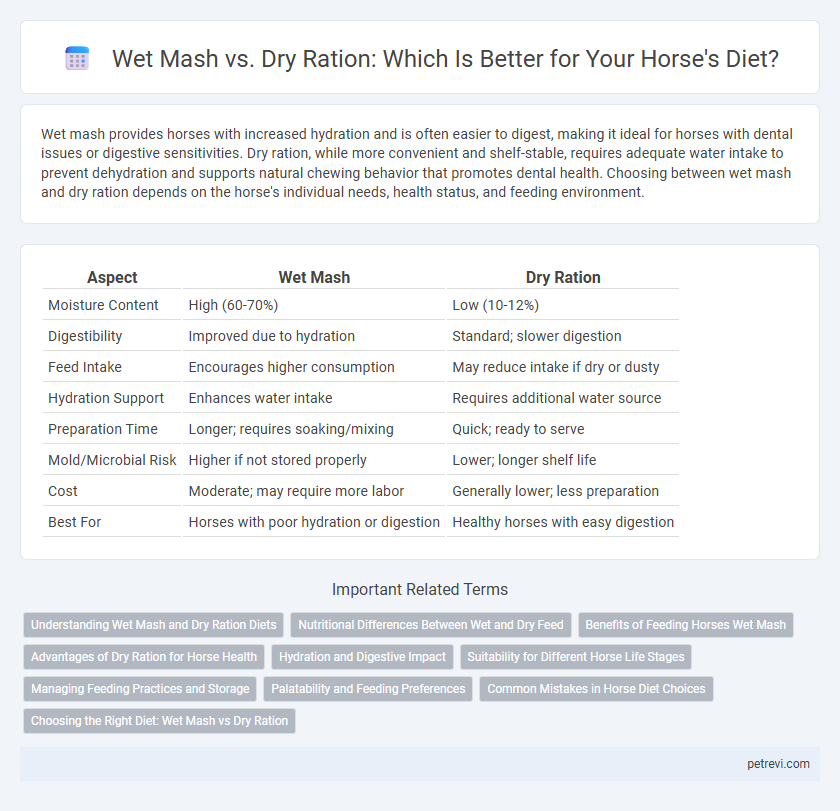Wet mash provides horses with increased hydration and is often easier to digest, making it ideal for horses with dental issues or digestive sensitivities. Dry ration, while more convenient and shelf-stable, requires adequate water intake to prevent dehydration and supports natural chewing behavior that promotes dental health. Choosing between wet mash and dry ration depends on the horse's individual needs, health status, and feeding environment.
Table of Comparison
| Aspect | Wet Mash | Dry Ration |
|---|---|---|
| Moisture Content | High (60-70%) | Low (10-12%) |
| Digestibility | Improved due to hydration | Standard; slower digestion |
| Feed Intake | Encourages higher consumption | May reduce intake if dry or dusty |
| Hydration Support | Enhances water intake | Requires additional water source |
| Preparation Time | Longer; requires soaking/mixing | Quick; ready to serve |
| Mold/Microbial Risk | Higher if not stored properly | Lower; longer shelf life |
| Cost | Moderate; may require more labor | Generally lower; less preparation |
| Best For | Horses with poor hydration or digestion | Healthy horses with easy digestion |
Understanding Wet Mash and Dry Ration Diets
Wet mash diets for horses involve soaking grains and feed in water, enhancing digestibility and hydration while reducing dust inhalation risks. Dry rations consist of unmoistened grains and forages, offering convenience and longer storage life but possibly less palatability and increased risk of choke. Understanding the nutritional needs and digestive health of horses guides the choice between wet mash and dry ration feeding strategies.
Nutritional Differences Between Wet and Dry Feed
Wet mash feed for horses typically contains higher moisture content, which enhances digestion and promotes better hydration compared to dry rations. Dry feed offers concentrated nutrients and longer shelf life but may require additional water intake to prevent dehydration and digestive issues. Nutritionally, wet mash can improve nutrient absorption by softening fiber, while dry feed maintains nutrient density but risks reduced palatability and slower digestion.
Benefits of Feeding Horses Wet Mash
Feeding horses wet mash enhances hydration and digestion by combining soaked grains and fiber, leading to improved nutrient absorption and reduced risk of choke or colic. The moisture content in wet mash supports digestive health and can encourage picky eaters to consume their feed more readily. Wet mash also aids in temperature regulation during hot weather by providing additional fluids alongside essential nutrients.
Advantages of Dry Ration for Horse Health
Dry ration offers precise nutrient control, allowing horse owners to tailor diets based on specific health needs and activity levels. It reduces the risk of mold and bacterial growth, promoting better gastrointestinal health and minimizing digestive disorders. Dry feed is easier to store and handle, ensuring consistent nutrient quality and stability over time.
Hydration and Digestive Impact
Wet mash diets increase hydration levels significantly, promoting optimal gut motility and preventing impaction colic in horses. Dry rations, while convenient, often lack moisture content, which can lead to decreased saliva production and less efficient digestion. Incorporating wet mash enhances microbial fermentation in the hindgut, supporting nutrient absorption and overall digestive health.
Suitability for Different Horse Life Stages
Wet mash offers enhanced hydration and digestibility, making it ideal for young foals and elderly horses with delicate digestive systems or dental issues. Dry rations provide stable nutrient density and are more suitable for mature, active horses requiring consistent energy intake. Adjusting the diet based on life stage ensures optimal nutrient absorption and supports overall equine health.
Managing Feeding Practices and Storage
Wet mash diets for horses require careful management of moisture levels to prevent mold growth and spoilage, ensuring fresh feed and reducing health risks. Dry rations offer easier storage and longer shelf life but necessitate precise portion control to avoid overfeeding and digestive issues. Proper storage for both feed types involves cool, dry environments and sealed containers to maintain nutrient integrity and prevent contamination.
Palatability and Feeding Preferences
Wet mash diets for horses often enhance palatability by increasing moisture content, which can encourage better intake and hydration. Horses typically prefer wet mash over dry rations due to softer texture and reduced dust, easing eating for those with dental issues. However, individual feeding preferences may vary, making it essential to monitor consumption and adjust diet formulations accordingly.
Common Mistakes in Horse Diet Choices
Common mistakes in horse diet choices often include relying solely on dry rations, which can lead to dehydration and digestive issues due to insufficient water intake. Wet mash diets provide better hydration and improve nutrient absorption, reducing the risk of colic and impaction. Ignoring the balance between wet and dry feed can disrupt a horse's gut microbiome, impacting overall health and performance.
Choosing the Right Diet: Wet Mash vs Dry Ration
Selecting the right diet between wet mash and dry ration is crucial for a horse's digestive health and nutrient absorption. Wet mash, typically consisting of soaked grains and supplements, improves hydration and eases digestion, making it ideal for horses with dental issues or sensitive stomachs. Dry ration offers convenience and longer shelf life, but it requires adequate water intake to prevent colic and maintain optimal gut function.
Wet Mash vs Dry Ration for Horse Diet Infographic

 petrevi.com
petrevi.com